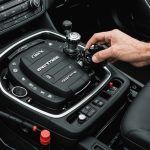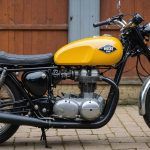Overview of Brake Fluid Maintenance for Honda Africa Twin
Proper brake fluid maintenance is vital for ensuring the optimal performance of your Honda Africa Twin. Regular maintenance not only enhances safety but also prolongs the life of your motorcycle’s braking system. The Honda Africa Twin requires specific types of brake fluid that meet manufacturer specifications. Using the correct fluid ensures compatibility and efficiency, reducing the risk of brake failure.
There are various kinds of brake fluid, usually denoted as DOT 3, DOT 4, and DOT 5.1. For Honda Africa Twin models, DOT 4 is commonly recommended due to its higher boiling point, making it suitable for conditions demanding robust performance. Always refer to your motorcycle’s manual to verify the ideal choice.
Additional reading : What are the key maintenance tips for keeping your motorcycle in top shape?
Recognizing when to conduct a brake fluid inspection is crucial. Common indicators include a spongy brake feel, a decrease in braking efficiency, and a fluid colour change to a dark, murky hue. If any of these symptoms are present, it’s time to check the brake fluid and possibly perform a change. Ignoring these signs can result in compromised braking ability, putting both the rider and the motorcycle at risk.
Necessary Tools and Equipment
To ensure effective brake fluid maintenance on your Honda Africa Twin, having the right tools is essential. Here are some important ones:
In parallel : How do you interpret motorcycle tire wear patterns to gauge performance?
-
Brake Bleeder Kit: This tool simplifies the process of draining and refilling brake fluid. It ensures a clean removal and replacement of fluid, preventing air from entering the system.
-
Wrenches and Screwdrivers: You’ll need wrenches for loosening and tightening bolts and screws. Make sure they fit the specifications of your motorcycle parts to avoid damage.
-
Safety Gear: Use gloves to protect your hands from corrosive brake fluid. Safety goggles are essential to shield your eyes, especially when dealing with fluid under pressure.
-
Fluid Catch Container: A container is necessary for collecting old brake fluid during maintenance, which aids in preventing environmental contamination.
Investing in high-quality maintenance tools ensures safer and more efficient brake fluid management. Additionally, purchasing tools specifically designed for the Honda Africa Twin can minimise errors and enhance the lifespan of your motorcycle’s brake system. Consider these tools as part of your motorcycle maintenance kit for a smoother, safer ride. Always refer to your Honda Africa Twin manual for tool recommendations and specifications.
Safety Precautions
Before starting any brake fluid maintenance on your Honda Africa Twin, observing critical safety measures is essential to protect both you and the motorcycle. Working in a well-ventilated and clean environment can help prevent inhalation of potentially harmful fumes and ensure no contaminants interfere during the fluid change.
Always use personal protective equipment such as gloves and goggles. This protective gear helps shield your skin and eyes when handling brake fluid, which is corrosive and can potentially cause severe injuries.
In the event of a brake fluid spill, swiftly clean the area to prevent any surface damage or slippery conditions. Use absorbent materials to mop up spills, and dispose of them following local environmental guidelines.
Ensuring all necessary tools are in good working condition before maintenance may prevent unforeseen accidents or complications. Regularly inspect and organize your tools, ensuring they’re stored safely when not in use. These maintenance safety practices provide a foundation for efficient and secure brake fluid management on your Honda Africa Twin, guaranteeing a safer experience overall.
Steps for Inspecting Brake Fluid
Proper brake fluid inspection is a key part of maintaining your Honda Africa Twin’s braking system. Follow these steps to ensure the effectiveness and safety of your motorcycle’s brakes.
Step 1: Locating the Brake Fluid Reservoir
Begin by identifying the brake fluid reservoir on your Honda Africa Twin. Generally situated near the handlebars for the front brakes and behind the engine for the rear, the reservoir must be easily accessible. This step is crucial as it allows you to perform a thorough examination and makes subsequent steps easier.
Step 2: Evaluating Fluid Condition
Once located, assess the fluid’s condition. Brake fluid should be clear or light amber; if it appears dark or opaque, it may indicate contamination or age. This is a strong sign that a fluid change might be necessary to maintain optimal performance.
Step 3: Checking Fluid Levels
Finally, ensure the fluid level is between the minimum and maximum markings on the reservoir. Low levels can lead to air entering the system, compromising brake efficiency. Regularly monitoring these specifics ensures motorcycle safety and performance, preventing unexpected braking issues on the road.
Steps for Changing Brake Fluid
Changing the brake fluid in your Honda Africa Twin requires precision and attention to detail. Follow these steps to ensure a smooth and effective process.
Step 1: Preparing for Fluid Change
Begin by gathering necessary items, including a brake bleeder kit, wrenches, and new brake fluid that meets specifications. Ensure your workspace is clean and well-ventilated. This preparation avoids confusion and provides a structured environment conducive to successful maintenance.
Step 2: Draining Old Brake Fluid
Secure the bleeder kit onto the valve, ensuring a tight fit. With a wrench, carefully open the valve to release pressure, allowing old fluid to flow into a catch container. This initial step is crucial, as it prevents air from entering the system, maintaining brake efficiency. Ensure all old fluid is thoroughly removed to avoid contamination when refilling.
Step 3: Refilling with New Brake Fluid
Close the valve securely before introducing the new fluid. Pour steadily, aiming for a continuous flow and minimising air bubbles. Regularly check the level, keeping it within recommended specifications. Bleed the brakes to remove entrapped air, ensuring optimal performance and safety. Properly conducted, these steps enhance the reliability of your Honda Africa Twin’s braking system.
Common Pitfalls and Troubleshooting
During brake fluid maintenance for your Honda Africa Twin, several pitfalls can occur if not addressed carefully. Awareness and understanding can prevent these common issues.
Firstly, improper bleeding of brakes is a frequent error. If you notice the brakes feel spongy or unresponsive after a fluid change, there may be air trapped in the system. In such cases, thoroughly bleed the brakes again to restore functionality.
Another troubleshooting aspect involves the handling of maintenance tools. Using inappropriate or poorly fitting tools might lead to damage. Always ensure you’re using tools specifically designed for the Honda Africa Twin, as this reduces the likelihood of errors.
Incorrect disposal of old fluid poses both environmental and safety concerns. Ensure you follow local regulations to properly discard used brake fluid, and never dispose of it in drains or regular trash.
Recognising these pitfalls and addressing them promptly supports an efficient and safe brake fluid maintenance process. This mindfulness ensures your Honda Africa Twin maintains its peak performance and safety standards during and after brake fluid changes. Remember, precision and attention to detail are key in preventing common issues.
Maintenance Best Practices
Implementing effective brake fluid maintenance tips ensures your Honda Africa Twin delivers reliable performance and safety. Establish regular intervals for inspecting and changing brake fluid—ideally every two years or 24,000 miles, whichever comes first. Prompt maintenance can prevent costly damage by keeping the braking system in peak condition. Regular checks can spot issues before they become problematic, ensuring optimal functionality.
Incorporating additional motorcycle maintenance activities can enhance overall brake performance. Routinely check for leaks around the brake lines and ensure that your brake pads are in good condition. Keeping these elements well-maintained helps preserve the efficiency and safety of the motorcycle’s braking system.
Staying organised with maintenance records is paramount. This practice aids in tracking scheduled upkeep, making it easier to maintain consistent Honda Africa Twin upkeep. Records could also benefit future owners or service technicians should issues arise.
Adhering to these best practices supports effective and efficient brake fluid management, safeguarding both the motorcycle and the rider. Thoughtful attention to maintenance intervals and consistent documentation builds a foundation for long-term reliability and enjoyment.











